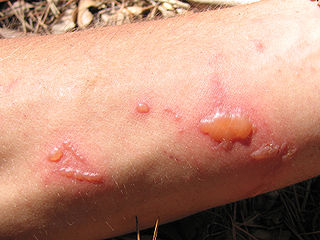
An essential oil is a concentrated hydrophobic liquid containing volatile chemical compounds from plants. Essential oils are also known as volatile oils, ethereal oils, aetheroleum, or simply as the oil of the plant from which they were extracted, such as oil of clove. An essential oil is essential in the sense that it contains the essence of the plant's fragrance—the characteristic fragrance of the plant from which it is derived. The term "essential" used here does not mean indispensable or usable by the human body, as with the terms essential amino acid or essential fatty acid, which are so called because they are nutritionally required by a living organism.

Lavender oil is an essential oil obtained by distillation from the flower spikes of certain species of lavender. There are over 400 types of lavender worldwide with different scents and qualities. Two forms of lavender oil are distinguished, lavender flower oil, a colorless oil, insoluble in water, having a density of 0.885 g/mL; and lavender spike oil, a distillate from the herb Lavandula latifolia, having a density of 0.905 g/mL. Like all essential oils, it is not a pure compound; it is a complex mixture of phytochemicals, including linalool and linalyl acetate.
Linoleic acid (LA) is an organic compound with the formula HOOC(CH2)7CH=CHCH2CH=CH(CH2)4CH3. Both alkene groups are cis. It is a fatty acid sometimes denoted 18:2 (n−6) or 18:2 cis-9,12. A linoleate is a salt or ester of this acid.

Eugenol is an allyl chain-substituted guaiacol, a member of the allylbenzene class of chemical compounds. It is a colorless to pale yellow, aromatic oily liquid extracted from certain essential oils especially from clove, nutmeg, cinnamon, basil and bay leaf. It is present in concentrations of 80–90% in clove bud oil and at 82–88% in clove leaf oil. Eugenol has a pleasant, spicy, clove-like scent. The name is derived from Eugenia caryophyllata, the former Linnean nomenclature term for cloves. The currently accepted name is Syzygium aromaticum.

Citrus bergamia, the bergamot orange, is a fragrant citrus fruit the size of an orange, with a yellow or green colour similar to a lime, depending on ripeness.

Limonene is a colorless liquid aliphatic hydrocarbon classified as a cyclic monoterpene, and is the major component in the essential oil of citrus fruit peels. The (+)-isomer, occurring more commonly in nature as the fragrance of oranges, is a flavoring agent in food manufacturing. It is also used in chemical synthesis as a precursor to carvone and as a renewables-based solvent in cleaning products. The less common (-)-isomer has a piny, turpentine-like odor, and is found in the edible parts of such plants as caraway, dill, and bergamot orange plants.

Phototoxicity, also called photoirritation, is a chemically induced skin irritation, requiring light, that does not involve the immune system. It is a type of photosensitivity.

Naringenin is a flavanone from the flavonoid group of polyphenols. It is commonly found in citrus fruits, especially as the predominant flavonone in grapefruit.
Carvacrol, or cymophenol, C6H3(CH3)(OH)C3H7, is a monoterpenoid phenol. It has a characteristic pungent, warm odor of oregano.

Procyanidins are members of the proanthocyanidin class of flavonoids. They are oligomeric compounds, formed from catechin and epicatechin molecules. They yield cyanidin when depolymerized under oxidative conditions.

Mitraphylline, an oxindole derivative, is an active alkaloid in the leaves of the tree Mitragyna speciosa, commonly known as kratom. As a non-narcotic constituent, it also occurs to a significant amount in the bark of Uncaria tomentosa along with a number of isomeric alkaloids.
Fluorogenic describes a property of chemical compounds which are initially not fluorescent, but become fluorescent through a chemical reaction, typically through an intermolecular covalent reaction which binds the now fluorescent compound to a target molecule. IUPAC uses a broader definition of fluorogenic, wherein a enhancement of fluorescence via a chemical reaction is not required, however in contrast to the IUPAC definition common use of fluorogenic does not refer to non-reaction effects like the enhancement of fluorescence from a fluorophore being in different solvents. Fluorogenic labeling reagents are often used in analytical chemistry procedures, particularly in HPLC or CE to derivative target compounds, thereby allowing enhanced sensitivity through fluorescence based detection.
F number is a correlation number used in the analysis of polycyclic aromatic hydrocarbons (PAHs) as a descriptor of their hydrophobicity and molecular size. It was proposed by Robert Hurtubise and co-workers in 1977.
A chromatography detector is a device that detects and quantifies separated compounds as they elute from the chromatographic column. These detectors are integral to various chromatographic techniques, such as gas chromatography, liquid chromatography, and high-performance liquid chromatography, and supercritical fluid chromatography among others. The main function of a chromatography detector is to translate the physical or chemical properties of the analyte molecules into measurable signal, typically electrical signal, that can be displayed as a function of time in a graphical presentation, called a chromatograms. Chromatograms can provide valuable information about the composition and concentration of the components in the sample.

Bergamot essential oil is a cold-pressed essential oil produced by cells inside the rind of a bergamot orange fruit. It is a common flavouring and top note in perfumes. The scent of bergamot essential oil is similar to a sweet light orange peel oil with a floral note.

Melitidin is a flavanone glycoside. Melitidin was discovered in bergamot orange juice and exhibits statin-like properties in preclinical research.

Brutieridin is a flavanone glycoside. Brutieridin was discovered in bergamot orange juice and exhibits statin-like properties in preclinical research, as well as an anticholesterolaemic effect.

Nerolic acid, also known as (Z)-3,7-dimethyl-2,6-octadienoic acid, is an organically-derived chemical.

Norclostebol acetate, or norchlorotestosterone acetate (NClTA), also known as 4-chloro-19-nortestosterone 17β-acetate or as 4-chloroestr-4-en-17β-ol-3-one, is a synthetic, injectable anabolic-androgenic steroid (AAS) and derivative of 19-nortestosterone (nandrolone). It is an androgen ester – specifically, the C17β acetate ester of norclostebol (4-chloro-19-nortestosterone).
An ultraviolet detector is a type of non-destructive chromatography detector which measures the amount of ultraviolet or visible light absorbed by components of the mixture being eluted off the chromatography column. They are often used as detectors for high-performance liquid chromatography.














